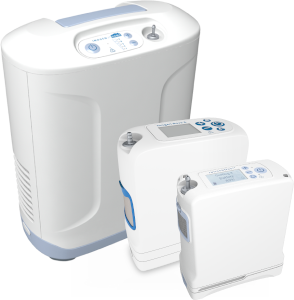What to Know About Oxygen Concentrator Liter Flow
Anyone beginning oxygen therapy or learning about a loved one’s oxygen needs will hear health care providers talking about liters per minute (LPM) when referencing an oxygen prescription. A patient’s liters per minute requirement is essential to the success of their oxygen therapy, but unless you know what liter flow is, these discussions could be hard for you to translate. Read on to learn more about liter flow and why it matters to your supplemental oxygen prescription.
What Is LPM?
If you are just learning about oxygen therapy, you may be confused by some of the terminology. You hear doctors talking about liter flow and LPM, but what is LPM and how does liter flow affect your oxygen therapy? Thankfully, the answer is not complicated.
Liter flow is the flow of oxygen you receive from your oxygen delivery device. This flow of oxygen is measured in liters per minute, or LPM.[1] Every liter per minute of oxygen increases the percentage of oxygen provided to the patient by about 3-4%. Keep in mind that the percentage of oxygen in our atmosphere, or regular breathing air, is just 21%.[2] With each LPM of supplemental oxygen, the patient receives an additional 3-4% of oxygen, so a patient receiving 3 LPM during oxygen therapy would be breathing air that is approximately 30-33% oxygen. For the majority of people requiring supplemental oxygen therapy, increasing their breathable oxygen to about 30-35% improves their blood oxygen levels, thereby providing therapeutic benefits.[1] Whether you use a compressed oxygen cylinder, a liquid oxygen tank or an oxygen concentrator, your oxygen could be dispensed to you based on the LPM prescribed to you by your doctor.
Home Oxygen Concentrator Liter Flows
If you are interested in using a home oxygen concentrator for your oxygen therapy, you could have some additional questions to ask your doctor. When you begin to discuss home oxygen concentrator liter flows and learn what LPM is to you, it’s important to understand the difference between the two types of oxygen flow delivery: pulse dosing vs. continuous flow oxygen. While both delivery types use LPM prescriptions, they deliver the oxygen in different ways.[3]
- Pulse Dosing: Pulse dose oxygen delivery customizes your oxygen delivery based on your breath rate. Pulse dose mechanisms are more sensitive, utilizing an oxygen conserver and other technology to deliver oxygen to the patient based on breathing rate and other factors. The sensor determines when the patient begins inhaling and delivers the oxygen pulse/bolus at that moment. Pulse dosing is akin to a glass of water with a straw; the intake will be based purely on the amount and intensity of sips.
- Continuous Flow: Continuous flow oxygen offers the same LPM continuously, regardless of the user’s breathing rate. The oxygen flows identically on your inhale and your exhale, meaning some of that oxygen will be wasted. Think of it like a water fountain: if you stand in front of a water fountain flowing at 1 liter per minute, you don’t actually drink one full liter of water. The amount of water you drink is determined by the number of sips and the size of the sip. The rest of the water is wasted. The same applies to continuous flow oxygen; the net amount of oxygen inhaled is a combination of the flow rate, the number of breaths and the size of the breaths.
Many of the small portable oxygen concentrators, like those made by Inogen, provide pulse dosing to offer the most customized oxygen therapy experience for you. Most stationary oxygen concentrators and traditional oxygen tanks provide continuous flow oxygen. When you discuss your LPM and liter flow prescription with your doctor, make sure to ask whether continuous flow or pulse dosing is right for your needs. The answer could have a significant impact on the oxygen delivery device you need to use.
Portable Oxygen Concentrator Liter Flows
Generally speaking, portable oxygen concentrators, including Inogen One Portable oxygen concentrators, typically offer liter flows from 0.21 – 1.26 LPM. Wondering “What is LPM availability with an Inogen One Portable Oxygen Concentrator?” Take a look.
Inogen One Model : Available LPM Flow Rates Ranges
Inogen One G3 : Pulse Dose: 1-5 Settings; 0.21 – 1.05 LPM
Inogen One G4 : Pulse Dose: 1-3 Settings; 0.21 – 0.63 LPM
Inogen One G5 : Pulse Dose: 1-6 Settings; 0.21 – 1.26 LPM
Your prescription will dictate how many flow settings you will need on your portable oxygen concentrator. Your liter flow requirement is one major deciding factor when choosing the right portable oxygen concentrator for you. However, there are other factors to consider before deciding which Inogen One is right for you. Explore our Inogen Product Comparison Chart to help you, and contact us for additional information.
Now you’ve answered, “What is LPM and how does it affect my oxygen therapy?” Find out how Inogen can help by giving us a call at 1-855-694-6643 today.
References
- Mandal, Dr. Ananya. “Oxygen Therapy Administration.” News Medical, AZoNetwork, 27 Feb. 2019, www.news-medical.net/health/Oxygen-Therapy-Administration.aspx.
- “Oxygen Therapy.” PCCS, Pulmonary Critical Care and Sleep Medicine Consultants, 18 Oct. 2011, www.houstonlungdocs.com/oxygen-therapy/.
- Chen JZ, Katz IM, Pichelin M, Zhu K, Caillibotte G, Noga ML, Finlay WH, Martin AR. Comparison of pulsed versus continuous oxygen delivery using realistic adult nasal airway replicas. Int J Chron Obstruct Pulmon Dis. 2017 Aug 24;12:2559-2571. doi: 10.2147/COPD.S141976. PMID: 28883723; PMCID: PMC5574700.







